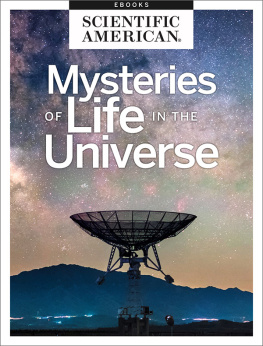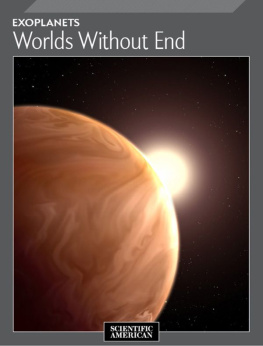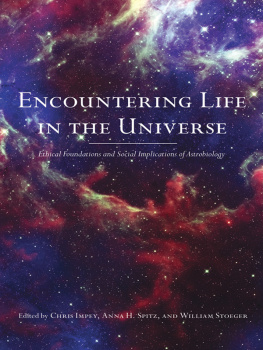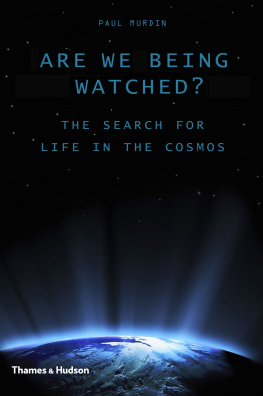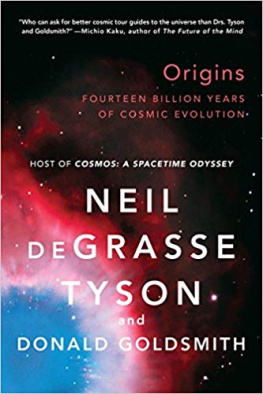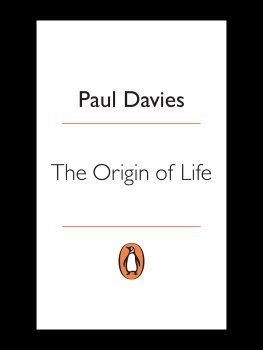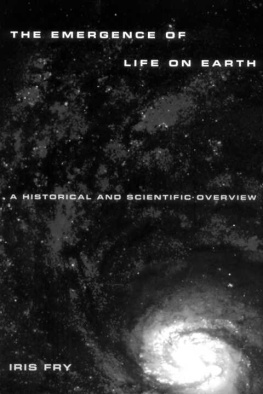Mysteries of Life in the Universe
From the Editors of Scientific American
Cover Image: Haitong Yu/Getty Images
Letters to the Editor
Scientific American
One New York Plaza
Suite 4500
New York, NY 10004-1562
or editors@sciam.com
Copyright 2018 Scientific American, a division of Nature America, Inc.
Scientific American is a registered trademark of Nature America, Inc.
All rights reserved.
Published by Scientific American
www.scientificamerican.com
ISBN: 978-1-2501-2157-8


MYSTERIES OF LIFE IN THE UNIVERSE
From the Editors of Scientific American
Table of Contents
Introduction
by Ricki Rusting
Section 1
1.1
by John Horgan
1.2
by Robert M. Hazen
1.3
by Alonso Ricardo and Jack W. Szostak
1.4
by Alexander S. Bradley
1.5
by Martin J. Van Kranendonk, David W. Deamer and Tara Djokic
1.6
by David Warmflash and Benjamin Weiss
1.7
by Paul Davies
Section 2
2.1
by Christopher P. McKay and Victor Parro Garca
2.2
by Van R. Kane
2.3
by Frank Postberg, Gabriel Tobie and Thorsten Dambeck
2.4
by Sushil K. Atreya
2.5
by Michael D. Lemonick
2.6
by Ren Heller
2.7
by Lee Billings
2.8
by Nancy Y. Kiang
2.9
by Alejandro Jenkins and Gilad Perez
Section 3
3.1
by Jill Tarter and Christopher F. Chyba
3.2
by Tim Folger
3.3
by Ian Crawford
3.4
by Ken Croswell
3.5
by Kimberly Cartier and Jason T. Wright
Section 4
4.1
by Anna von Hopffgarten
4.2
by Cameron M. Smith
4.3
by Lawrence M. Krauss and Glenn D. Starkman
To Life! Here, There, Everywhere
How did life get started on Earth? Do microbes, or even intelligent beings, lurk elsewhere? How will life end? All these captivating questions remain unsolved.
Theories of how life on Earth evolved seem almost as varied as life itself, as we see in the opening section of this eBook, Origin of Life on Earth. Some scientists posit that the first microorganisms came from outer space. Charles Darwin, famous for his theory of evolution, thought they might have originated in a warm little pond. Others propose that life began near hot vents in the seafloor. Still others look to volcanic springs. Maybe the first molecules of life consisted of RNA; maybe smaller molecules came first. Possibly minerals were key.
Researchers study the origin of life on this planet in part to gain clues to finding it on other bodies. Liquid water and moderate temperatures can set astronomers hearts racing, although it turns out that life may sometimes thrive in extreme environments. Promising places for past or present life include Mars, Saturns moons Titan and Enceladus and Jupiters moon Europa. They also include planets around other stars; exoplanet hunters propose that certain of them could be more hospitable to life than Mother Earth.
Most searches assume that life elsewhere will be like living matter herecontaining carbon-rich molecules, for instance. But life could be different on distant worlds, based on silicon, perhaps, or with arsenic in place of phosphorus. Plants growing on other planets could be red, blue or black, instead of green. Even universes with different physical laws might be habitable, some say. Read about how investigators go about searching for life beyond Earth in the section Where Life Lurks.
Of course, many people most want to know whether intelligent counterparts of humans rule on distant orbs, and the section titled The Search for Extraterrestrial Intelligence addresses that question in depth. Efforts to spot signs of sentient beings have been under way for more than 100 years but have come up empty so far. Nevertheless, they continue. Some investigators think extraterrestrials are worth at least considering as the cause of a mysterious dimming of light from a distant object known as Boyajians star.
No discussion of life would be complete without considering its demise. Scientists expect that one day, many eons from now, the cosmos will become so cold and empty that no life will survive, as an article by Lawrence M. Krauss and Glenn D. Starkman in the Lifes Future section explains. For now, though, lifes many mysteries continue to fascinate.
-Ricki Rusting
Book Editor
SECTION 1
Origin of Life on Earth
In the Beginning
by John Horgan
In 1953, what is arguable the greatest mystery ever puzzled over by scientiststhe origin of lifeseemed virtually solved by a single, simple experiment. Stanley L. Miller, then a 23-year-old graduate student at the University of Chicago, re-created the primeval earth in a sealed glass apparatus. He filled it with a few liters of methane, ammonia and hydrogen (the atmosphere) and some water (the oceans). A spark-discharge device zapped the gases with simulated lightning, while a heating coil kept the water bubbling.
Within a few days, the water and glass were stained with a reddish goo. On analyzing the substance, Miller found to his delight that it was rich in amino acids. These organic compounds link up to form proteins, the basic stuff of life. Miller's results, which he published in a modest two-page article in Science, seemed to provide stunning evidence that life could arise out of simple chemical reactions in the "primordial soup."
Pundits speculated that scientists, like Mary Shelley's Dr. Frankenstein, would shortly conjure up living organisms in their laboratories and thereby demonstrate in detail how genesis unfolded. It hasn't worked out that way. "The problem of the origin of life has turned out to be much more difficult than I, and most other people, envisioned," said Miller, then a professor of chemistry at the University of California at San Diego.
Of course, there has bene progress since 1953. That same year, in fact, James D. Watson and Francis H. C. Crick deciphered the structure of deoxyribonucleic acid (DNA), whose double-strand helix carries the information that cells need to build and organize proteins. Over the next few decades, experiments similar to Miller's demonstrated how the components of DNA (which are called nucleotides) as well as those of proteins could have been synthesized under prebiotic conditions. These organic compounds could have accumulated in various bodies of water: in some "warm little pond," as Charles Darwin once speculated in aletter, or in tidal pools or shallow seas.
Experiments in the early 1980sseemed to complete the picture. Theyrevealed that ribonucleic acid, or RNA,a single-strand molecule that serves asDNA's helpmate in manufacturing proteins,might have the ability to makecopies of itself without the assistanceof enzymes. Some investigators concludedthat the first organisms consistedof RNA and that an early "RNAworld" had provided a bridge fromSimple chemistry to prototypes of thecomplex DNA-based cells found inmodern organisms. According to thefossil record, such cells emerged withinthe first billion years after the earthhad formed 4.5 billion years ago.

